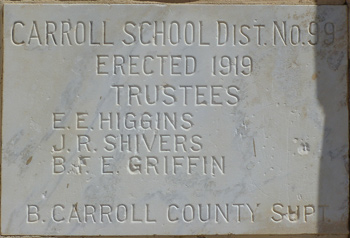Location: 1055 N. Carroll Ave., north of Texas 114, next to the former Carroll Intermediate School (now Southlake Baptist Church). The 1919 school is next to the first Dragon football field.
The first school in our award-winning school district. The place where the city of Southlake was born. That’s the 1919 Carroll School, a place that once was the heart of the community.
Sadly, over the years the schoolhouse was largely forgotten. In 2004, when the Southlake Historical Society began to research it, few school district and city officials knew much, if anything, about it.
The Southlake Historical Society has worked to find ways for the school district and/or the city and/or private groups or individuals to save and reuse the building, but we have not been successful. The land the 1919 school sits on has become very valuable, and CISD plans to sell the property. After it’s sold, the 1919 Carroll School likely will be demolished, although the SHS hopes a developer will see the benefits of saving and reusing it. (Whoever purchases the building and land may only want to restore the original 1919 portion.)
Those benefits include the good will of people in Southlake and surrounding communities who will appreciate that a building with such significance to the community has been saved.
The SHS has urged the school district to give potential buyers/developers information about historic tax credits and ways to reuse the school, but to our knowledge the district has not done so. Tax credits for restoration and reuse are given if the building is to be used for a depreciable purpose. Reusing the school — as a rental office, a meeting space, a retail store (perhaps for green products, as the original school was exceptionally green) or other business use –would give a developer an authentic theme: Schoolhouse Square. The sign at right shows such a development in vibrant Hastings, Minn.
The school district offered to donate the school to the SHS so it could be moved, perhaps to the Bob Jones Nature Center, but the SHS does not have the resources for such a project.
Thanks to the Southlake Baptist Church, the school is looking better on the outside than it has in years. Members of the church, which is renting the former Carroll Intermediate School next door, repainted the school (since it had been previously painted, our preservation architect did not see a problem with another coat), dealt with water-intrusion issues by repairing the roof and removing several window air conditioners, and added cleverly made fake windows that, from a distance, look real.
The original 1919 portion of the school, built in a T-shape, is on the left; three more rooms were added after World War II. After Johnson Elementary was built in 1960, the old school served as an art studio, warehouse and transportation office. It was closed in 2001.
Both the National Trust for Historic Preservation and the Texas Historical Commission agree that the 1919 Carroll School is significant to our community. The Trust awarded the SHS a grant from the Meadows Fund for Historic Schools so that the condition of the school could be assessed by a structural engineer. The Texas Historical Commission awarded the 1919 Carroll School a historical marker, which has been placed next to Carroll Avenue in front of the school.
To preserve as much as information as possible about the school, the SHS had a preservation architect do drawings of it, inside and out. Someday – like the city of Allen did by building a replica of its old train station, for education and community events – Southlake might want to build a replica of this community treasure. For that reason, if/when the school is demolished, it’s hoped that as much as possible of the original brick (from west of Fort Worth) and wood (old-growth pine from East Texas) is saved.
In the meantime, the SHS and the Carroll ISD have sought to stop termite damage and to “mothball” the building according to the U.S. Secretary of the Interior’s standards in case someone does choose to reuse it. Mid-Cities Pest Control treats the building, inside and out, for termites. Unfortunately, asbestos in the floor tiles prevented more extensive treatments.
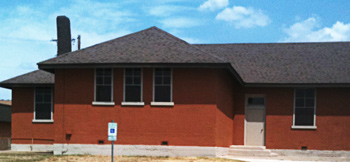
[Its architecture] “is as plain, sturdy and as practical as the farmers who built it,” the granddaughter of B. Carroll, for whom the district is named, told Carroll ISD trustees in 2009.
“It has served this community as an example of the pioneer spirit of this area. In this throwaway society, it is important to have an anchor to the past. It takes tangible things, something to touch, to remind all of us of the history that has gone on before.”
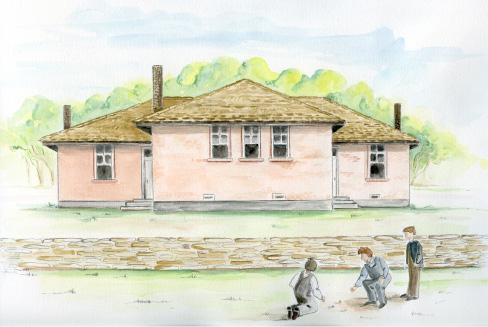
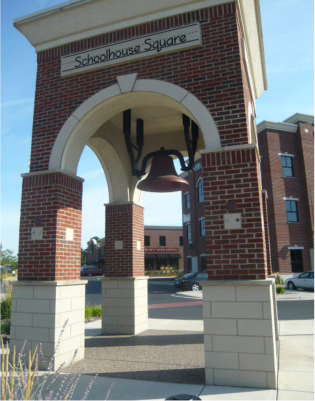
An Anchor to the Past
by Mary Ann King, B. Carroll’s granddaughter, from a speech given to Carroll ISD trustees
My grandfather was Burrell “Burl” Carroll. All his life he went only by the initial “B” – B. Carroll. His life was just as straightforward and to the point as his name. He graduated from college and taught one year before coming to Texas from Tennessee with his wife and daughter in 1898. He referred to himself as Professor Carroll, his occupation listed on the census was “Educator.” He spent his life as a teacher and principal in most of the small towns across Tarrant County.
In 1884, the state of Texas sought to give uniformity to the curriculum in public schools, and the elected office of County Superintendent of Public Instruction was formed. B. Carroll had taught in so many of the Tarrant County schools and was familiar to the people in this area, and he won the election in 1918. In 1917, the schools of Lonesome Dove, White’s Chapel and the eastern portion of Sams [along with the Union/Easter district, which was not holding school because the school had burned] were combined into what was designated as Common School District No. 99. By 1919, it was called Carroll Common School District No. 99, for B. Carroll.
The original Carroll building is plain in design and serviceable in intent. This building has no outstanding architectural features. It is as plain, sturdy and as practical as the farmers who built it. It has served this community as an example of the pioneer spirit of this area. In this throwaway society, it is important to have an anchor to the past. It takes tangible things, something to touch, to remind all of us of the history that has gone on before.
This Carroll building still has the potential to take an active part in the continuing development of this community as well as a link to the history of its beginning. The possibilities are endless. I hope you see fit to give it a chance.
Mary Ann King spoke to the school board on March 2, 2009, on behalf of the 1919 Carroll School. (Mrs. King died in 2010 and is buried in Fort Worth next to her grandfather.)
Other distinguished speakers at the meeting were:
Rebecca Utley, whose great-grandfather John Shivers was on the school board when Carroll School was built.
Eddie Cheatham, the first Dragon quarterback, whose father was president of the school board when Jack Johnson was hired in 1957.
Mary Hays Koenig, who attended Carroll School during the 1940s and remembered how patriotic the school was.
Johnny Tate, Southlake’s third mayor and a former school board member, and his son, Dr. Michael Tate.
Jack Cook, who attended 10th grade at Carroll School in 1930s.
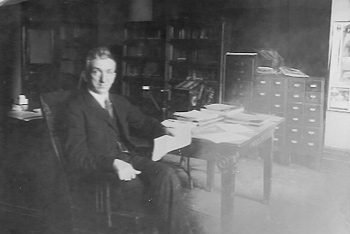
B. Carroll, not B.H. Carroll
Carroll ISD’s namesake B. Carroll — also known as B.E. Carroll — should not be confused with B.H. Carroll, a Baptist theologian and educator.
To learn more about Tarrant County Superintendent of Public Instruction B. Carroll, see the collection of his papers at the Tarrant County Archives in downtown Fort Worth, http://tcweb.tarrantcounty.com/e-archives/cwp/view.asp?a=874&q=481470
Carroll’s niece, Beverly Davis, allowed the SHS to study the papers before they were donated and copy from them information relevant to our area.
What Carroll School Means to Southlake
Small-town meeting places may be coffee shops or churches, somebody’s home, or . . . the school.
From the start, the Carroll School was Southlake’s meeting place. When the county judge called the town’s very first election in 1956 to decide whether or not to incorporate, the election was held in the Carroll School. Council meeting minutes show that the council met one Saturday a month at the Carroll School.
City fathers and mothers valued their school: In 1957, Mayor Gail Eubanks stated, “Since we have used the Carroll School for a year and a half for a meeting place, it might be nice to make a small cash gift to the school to show our appreciation.”
The school was the hub of activity in those early years; students and teachers coming and going during the week; on the weekends, town business and elections, fall carnivals and football games on the 80-yard, hand-sprigged field.
Someone who watched over the school in those days, long-time CISD superintendent Jack Johnson, spoke of the Carroll School in an oral history he gave the SHS in 2004. “Southlake was only 1-year old when I got here. My wife, Modean, and our two small children arrived in Southlake when the Carroll School was in the Carroll Common School District (before residents voted to become the Carroll Independent School District),” explained Mr. Johnson.
“I was hired as the principal. It was an eight-grade school with 125 students, six teachers, and a three-member board of trustees.” Mr. Johnson would remain at the helm of the CISD for 30 years, becoming the district’s longest-serving superintendent.
The meetings continued outside the Carroll School as well. The Johnson’s house sat where Carroll Intermediate School sits today. Many mornings, according to Modean Johnson, as the “the mothers would drop their childen off at school,” she recalled, ” they would drive on around and stop to have a cup of coffee with me. I have such fond memories of all those families.”
Some of those families remain in Southlake still. And the original Carroll School sits on the same spot where it was built in 1919, watching the acres and acres around it change. Gone are the horse farms, and two-lane roads that led to small houses with big pastures and a barn. But somehow this is the image of Southlake that many of us carry around with us as we run carpool or swing by the grocery store.
What makes the permanent mark of a great community? I suggest that along with an exemplary school district, a vibrant economy, and involved citizens, a great community is one that offers residents and visitors alike exciting possibilities for the future and a vivid sense of its past. Our community is blessed with a building, humble as it is, that for many years was the only public building. The Carroll School served both the city of Southlake and the Carroll Independent School District well. It’s time to return the favor.
— By Connie Cooley, Southlake Historical Society

History of Carroll School and the School’s Current Condition (2010)
Carroll School is the oldest public building in Southlake — and until the 1960s, the only public building. It is the last remaining Common School District school in Tarrant County. (The Old Bedford School is from the same era but was mostly rebuilt after a fire in the early 1990s.)
Carroll School was built in 1919 after several rural districts – Dove, White’s Chapel and the eastern portion of Sams – had been consolidated in 1917 to form Common School District No. 99. Students in Union, formerly Easter, also were included in No. 99. (In 1917, Union existed in name only because its building had burned; children in the rural district went to Pleasant Run in Colleyville or to White’s Chapel.)
By 1919, No. 99 was named for B. Carroll, a longtime teacher and principal who in 1918 became the Tarrant County superintendent of public instruction. Carroll School originally was grades 1-9. Later, grade 10 was added, although the school had only 8 grades at the end (high schoolers went to Grapevine).
The school represents the commitment that residents in this poor, rural, unincorporated area had to education. In 1919, with property values in the new school district totaling $207,400, residents (well, men; women couldn’t vote) voted to raise their taxes for the purchase of $7,500 in bonds to pay for the “site, construction and equipping [of] a brick school building.”
For years, the school was the centerpiece of the community. In 1956, it was where residents came to vote on whether to incorporate as the Town of Southlake.
1919 was also the year the McPherson farmhouse — on today’s Town Square property — was built. The house was demolished in advance of Town Square.
Style, Construction
The one-story school, which faces west, is of load-bearing masonry construction. It rests on a pier-and-beam foundation with a concrete base around its perimeter. In the teens, old-growth (virgin) pine was being brought from East Texas to the lumberyard owned by the school’s builders, and it no doubt was used in the school’s foundation, floors and tongue-and-groove ceilings.
The building is vernacular in style and lacks signs of ornamentation and architectural detail (none are known to have existed). Built on one of the higher points of land in the area, the school has sweeping views to the south and west. It originally had more than 19 windows (the exact number isn’t known, as one wall was removed for an addition), to let in light and breezes.
Frank Estill was the school’s builder and contractor. His father, C.C. Estill, owned a building supply store and lumberyard in Grapevine; Frank Estill later became a Tarrant County commissioner. The Estills built other schools in the area, including the Pleasant Run School in Colleyville in 1912 (demolished in 2011) and the Old Bedford School in Bedford in 1915. The Old Bedford School was entered into the National Register of Historic Places in 1997, although it had burned in the early 1990s and was rebuilt as a replica. Records at the Billy Sills Center and libraries show that the other county schools from the era have been demolished. Only one original Common School District school in Tarrant County still exists — the 1919 Carroll School.
Carroll School probably was the first brick building in town, as all known houses, churches, country schools and businesses were wood-framed, local stone or log. An area map based on remembrances of old-timers included a still, taverns, cotton mills, churches, blacksmith shops and country stores.
The original school consisted of three rooms that formed a T: two side-by-side rooms along the back (running north and south) and the third midway between them, facing west. The two rooms along the back were actually one room with a chalk board divider that could be moved to make one large room. On the south side of that large room was a stage. Two painted wooden doors, one on either side of the room on the front, led into the school. A fourth classroom was added in 1945 and two more in 1951, extending the north-south rooms to the south and adding another room onto the front of the building, creating something of a U. For many years, two outhouses stood in the back (one for boys and one for girls); later, restrooms were part of a concrete block building in back, then indoor plumbing was added. The original site, purchased in 1919, was 5 acres.
Bricks used on the exterior are 8-1/16” x 3-13/16” x 2-1/4” and extend from the foundation to the roof. A common bond is used, with five rows of stretchers, then a row of headers. The exterior walls are approximately 13 inches thick, indicating three wythes of brick masonry. This also could be seen through the hole left by the missing brick.
According to the Old Beford School’s National Register nomination, bricks for that school, built by the same man who built Carroll School, “reportedly were laid just a fraction of an inch inward from the row beneath it, so that each wall angled slightly inward. … The lost art supposedly prevented some settling and cracking.” I was unable to detect such angling, although a professional conservator might.
At a spot where one brick is missing, allowing for a full-brick measurement, no brickyard stamp could be seen. Jeroll Shivers, whose grandfather was on the school board when the building was built, said the bricks were brought from Fort Worth by mule wagon. The hauler was paid 1 cent a brick. Of the three brick companies known to be in Fort Worth in 1919, all three were manufacturing bricks west of Fort Worth.
Photos show that the original building was not painted, and pictures through the 1960s show it as unpainted. In 1991, the school was painted a yellow-beige. Bricks in the front that have had the paint blasted off by water, and bricks seen through a ventilation hole where a brick is missing, are pinkish-red.
Two brick chimneys, painted a grayish color, are on the north side of the building and originally were vents for wood- and/or coal-burning stoves. Other chimneys may have been located on the south side of the building, but the wall was taken out about 1950 to add new classrooms. Before 1957, gas heat was added to the building.
Because the property slopes to the west, the foundation is as much as 20 inches aboveground in the front and is belowground (plus two bricks) in the back. The soil around the building is mostly sandy.
Originally, the school had approximately 23 windows, 16 of which were 4×4 double-hung wooden windows with brick sills. At least three others were smaller, also with brick sills. In the original three-room building, 10 windows were in the back and faced east; five were on the front and faced west; and four were in the side of the jutting room and faced south. It’s assumed that four were in the wall that was taken out when the additions were made, as the building is very symmetrical.
The two additions, reportedly built in 1945 and 1951, added 10 more 4×4 double-hung wooden windows with sills, one facing east and nine south. All of the windows were bricked up in 1991. It’s easy to tell where the windows had been, as the bricked-in areas consist entirely of stretchers.
In contrast, the three rooms added in 1945 and 1951 are faced with brick veneer in a common bond pattern. In one of the rooms along the back, concrete blocks can be seen in the wall. Apparently these rooms sit on concrete.
The original roofing material was undoubtedly wood shakes, and the wood shakes can still be seen in the attic.
Site, Uses
From where the school sat high on a hill (it was sometimes called Carroll Hill School), students could watch as nearby Texas 114, completed in 1932 along a roadbed purchased from a bankrupt railroad, was built by men using mules and graders. In 1934, along 114 and not far from the school, Bonnie and Clyde gunned down two Texas State troopers. A few miles to the northeast sits Lonesome Dove Baptist Church, established in 1846. (The name Lonesome Dove was made famous worldwide by author Larry McMurtry.) During WWII, troop convoys would move along 114, and the children would stand outside Carroll School and wave.
Carroll School remained an elementary school into the 1960s. After the growing district built an elementary school in the late 1970s, the old school did duty as a warehouse, art studio and bus transportation office. It was closed in 2001. It still houses maintenance-department supplies and late-20th-century desks, chairs and supplies that have outlasted their usefulness.
Today, Carroll School sits adjacent to a five-building former intermediate- and high-school campus now rented by Southlake Baptist Church. The high school, the district’s first, was constructed in the early 1960s. Other buildings in the group were built in the 1970s.
Adjacent to the Carroll School is something that many people might also have a passion for preserving: the first football field of the state champion Carroll Dragons.
For years, a forest of trees stood behind the school. Today, fenced pastures, a tin-roofed barn and groves of trees behind the school give it a rural flavor, but across the street a large office complex has just gone up, and a mega church has purchased a large parcel of land to the south. The school sits several hundred feet back from Carroll Avenue.
Maintenance, Recommendations
No maintenance records can be found, and no one remembers any ever existing. Jack D. Johnson, who came to the district in 1957 as the principal and later became the superintendent, said he hired local men to do repairs as needed. An oral history tells of the students bringing rakes to clean the schoolyard the first day of school in the early 1920s. The principal is remembered as the one in charge of maintenance.
Mr. Johnson told of repointing as part of the maintenance done to the building after he arrived in 1957; surely it had been done before that as well. The repointing Mr. Johnson directed was done by locals using locally available materials. It’s hard to see what color and texture it is because of the paint. In one obvious place near the front door, school maintenance workers in probably the 2000s tried to blast the paint off. The work was stopped when it became obvious that the mortar was coming out, too. In a few places, the mortar has been replaced with cement.
Cement and other inappropriate repairs are destructive to old brick and the building overall.
The roof was last replaced in 1991, and it is said to leak in at least one place. Missing mortar and the two vertical seams where the additions join the original school also present opportunities for water to enter the school. Termites are also a threat to the building.
I have talked with Dr. Faltys, Derek Citty, Chauncey Willingham and then-School Board President Erin Shoupp, and all have been helpful. They and other school and community leaders have expressed an interest in preserving Carroll School. Preservation grants, tax credits for fixing up a historic building for commercial purposes, private donations and some public money could be used to preserve the school for its educational and tourism value.
Since fall 2008, I have recommended that a preservation specialist assess the building and advise how to “mothball” it according to the Secretary of the Interior’s guidelines. At the least, I recommend that the most-important repairs be made so that the building will remain structurally sound and usable into the future. (Since then, important repairs have been made by the SHS and the Carroll Baptist Church.)
— By Anita Robeson, Southlake Historical Society
Sources include
Southlake Historical Society archives
Southlake Historial Society members Anita Robeson and Connie Cooley
Mark LeMay, Jaster Quintanilla Engineering, Dallas
Nancy McCoy, Quimby McCoy Preservation Architecture, Dallas
Mid-Cities Pest Control, Bedford
Mary Ann King, granddaughter of B. Carroll
Carroll ISD former Supt. Jack D. Johnson
Modean (Mrs. Jack D.) Johnson
Tarrant County Commissioners Court archives, for court minutes that included actions affecting No. 99, later Carroll
Dawn Youngblood, Tarrant County Archives, Fort Worth
Tarrant County Archives, Fort Worth, for lists of teachers and students from 1919-1920s
Billy W. Sills Center for Archives of the Fort Worth ISD, Fort Worth, for histories of area Common School Districts
Heritage Room of Tarrant County College Northeast, Bedford
U.S. Secretary of the Interior’s Standards for Historic Preservation
Old Bedford School nomination for National Register of Historic Places
